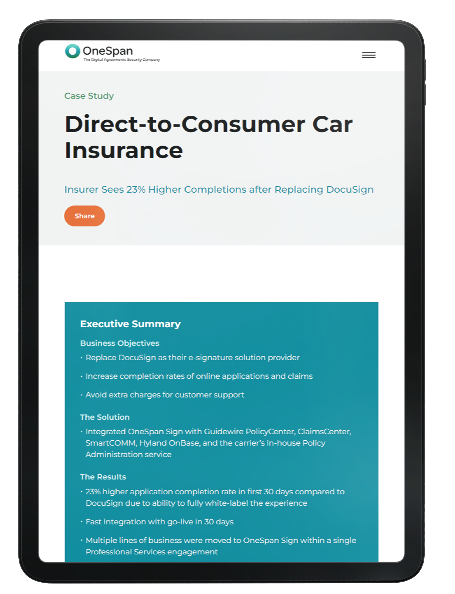How the Insurance Sector is Undergoing a Massive Digital Overhaul

Innovation through new technologies has been a critical driver of change in the banking and financial sector, leading to efficiency gains, better risk management and new revenue streams.
The insurance sector is no exception to such developments, with possibilities of new methods of service provision, opportunities for data collection and fraud detection, as well as the potential to reach uncovered segments.
During Fintech Fireside Asia’s latest panel discussion, C-level executives from multinational insurance firm AXA, Singaporean insurtech startup Bolttech, digital insurer OneDegree technology arm IXT, and cybersecurity technology firm OneSpan, shared their views on the most impactful digital trends affecting the insurance industry and delved into how they believe the sector will look like in the future.
Speakers were unanimous on the need to provide contextually relevant and personalized insurance coverage, highlighting how big the embedded insurance trend has become this past year.
“The biggest trend in the sector is around embedded insurance … and new ecosystem platforms are [leading] incumbents by the nose to innovate and look at the technology capabilities to be able to cater to these kinds of solutions,” Shawn Lau, General Manager for Southeast Asia, IXT by OneDegree, said during the panel discussion.
One key driver of this trend has been COVID-19, said Sameer Hajarnis, Vice President, Growth and Transformation, OneSpan.
While digital adoption had increased prior to the outbreak, the pandemic has undeniably accelerated that trend, changing customer expectations and transforming the way they purchase insurance.
“People want to transact from the comfort of their house. The model of engaging someone has changed,” Sameer said.
“Especially with the new generations, the Millennials, the Gen Z: they are a digital-first kind of buyers, they are not looking to engage in traditional models as their parents.”
Data and open APIs as major enablers
For Tomasz Kurczyk, Chief Transformation and Digital Officer, AXA and a committee member at the Singapore Fintech Association, initiatives from government agencies aimed at fostering innovation and competition, like new licensing regimes and open banking frameworks, have been the true enabler of innovation in the insurance space, highlighting the opportunities brought about data sharing and analytics.
“The biggest change for the industry that’s allowed the industry to leap a few steps, is the initiatives pushed by the government to establish open APIs, and data standardization,” Tomasz said.
“This is opening a completely different playbook for players, and is enabling them to innovate around products, distribution, and the protection gap.”
Insurers have historically collected a wealth of data but have been slow to monetize this asset.
But now, with the growth in analytics technologies, the declining cost of computing power and data storage, and the explosion of available customer data, the insurance industry is eagerly seeking to exploit that treasure trove to gain a deeper understanding of their customers, and make use of artificial intelligence (AI)/machine learning (ML) to gain in efficiency.
“The amount of data collected today gives you better insights into the customer journey and if you combine that with AI models, you can do better risk modeling, propensity modeling around this, to come up with something more accurate in terms of product and price, and be more competitive around it,” Sameer said.
“From a risk perspective, … you can do a much better job at staying in good books with the regulators, especially with issues such as money laundering and the financing of terrorism. You are actually in a much better position to handle the constraints that regulators put on you with a digital-only channel than with the traditional route because being able to get that data and be able to scale that at real time is very difficult in a traditional model.”
Untapped opportunities
In Southeast Asia, where insurance penetration is less than 3%, digitalization and data can be great levers for the industry to reduce the protection gap, opening up an entirely new spectrum for insurers to cover risk and providing means to overcome the major obstacles for people and businesses to buy insurance, including affordability and ease of access, said Melissa Wong, Group Chief Product Officer, Bolttech.
Having access to more data means the possibility of greater data analytics and in particular improved predictive analytics. This ultimately leads to better suited pricing to the expected risk, fairer premiums, and, potentially, greater availability of insurance for all consumers.
“We see that people are being dropped all the time and this is a common theme around the world,” Melissa said.
“To me, that’s the biggest gap: that there are people out there seeking and demanding for this service and we can’t, as an industry, meet it. If we are able to leverage and see what people need more effectively, we are able to match to the consumer’s needs.”
The future of insurance agents
While it is a fact that policyholders are interacting more and more in the digital realm, the speakers were undivided on the belief that physical agents won’t be displaced anytime soon, noting that customers still view human touchpoints as more trustworthy when in need.
“Across the board, offline is still here to stay,” Melissa said. “In the US, we’re still seeing a 50% to 60% drop from online to offline … Insurance is a financial product it requires trust, and people still want that human touch.”
Echoing Melissa, Shawn said “digital will never overtake physical agents,” adding that complex products will still require some kind of human intervention to close a sale.
“It will always be a blended approach to make sure that the customers are better served.”
For Tomasz, though insurance agents won’t be going away, their role will change significantly. Digital channels will remain convenience leaders, offering customers quick and 24/7 access to relevant information, but physical agents will evolve into the go-to channel for customers seeking insurance expertise and personalized advice.
“The future physical agent has three roles: one is to be a ‘fin-fluencer’, second is to be a holistic financial advisor and an advisor on the financial well-being of a customer, and the last one is to become an affiliate and monetize all these steps in educating the customer,” Tomasz said.
Learn more about the challenges and opportunities of digital transformation in this interview with Security Guy TV
The road ahead
Speakers concluded that despite recent strides from incumbents to embrace innovation to tackle the protection gap, offer superior customer experiences and improve efficiencies, there were still room for improvement and some challenges to address.
For one, Tomasz highlighted poor data quality, especially when a physical distribution is involved, as a major hurdle compromising not only insurers’ ability to engage meaningfully with customers but also undermining their risk management.
“There’s a legacy of culture, of incentives, as well as big problems coming from change management that impact data quality,” Tomasz said.
“This has a domino effect on how well you will be able to engage, communicate, retain the customer as well as building a strong foundation of understanding. And later on, [this will impact your ability to] … roll out different products, underwrite the risk, cover the new types of risks that you are not covering, and so on.”
There also needs to be a greater focus on retaining existing customers, an area that’s often overshadowed by customer acquisition.
“Customer retention is a big issue, because around 90% of the time and resources are spent on acquiring customers and only 10% on retaining customers,” Tomasz said.
“This is very surprising and strange in a way because, if you look at the profit generation pool, the relationship is inverse: the most of the money is coming from the existing portfolio not from the new customers.”
This blog, was first published on FintechnewsSingapore.










